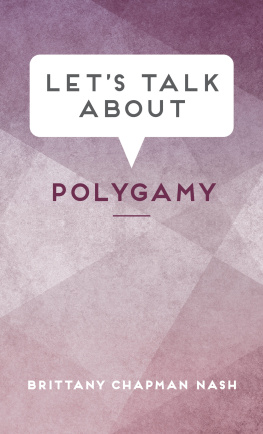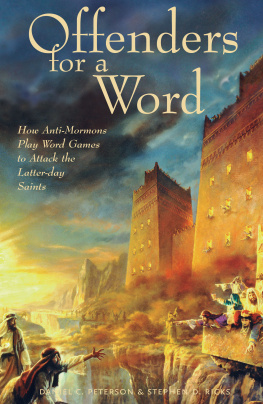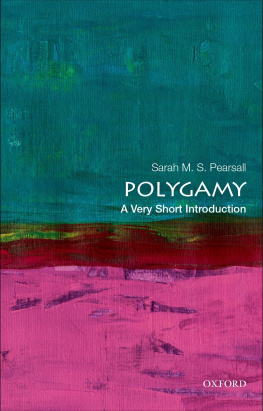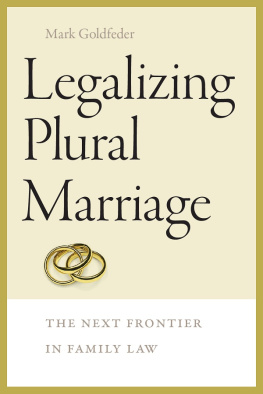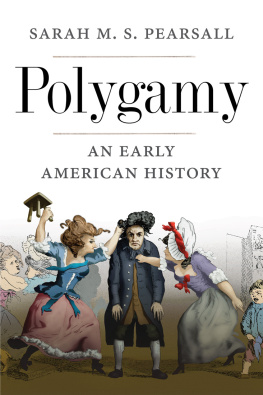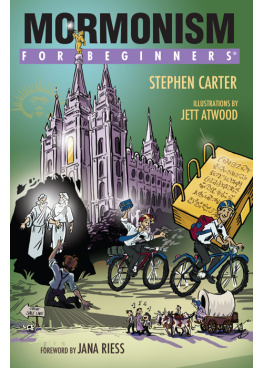Book design Deseret Book Company
Cover image Apostrophe/Shutterstock.com
Art direction: Richard Erickson
Design: Emily Remington
2021 Brittany Chapman Nash
All rights reserved. No part of this book may be reproduced in any form or by any means without permission in writing from the publisher, Deseret Book Company, at permissions@deseretbook.com. This work is not an official publication of The Church of Jesus Christ of Latter-day Saints. The views expressed herein are the responsibility of the author and do not necessarily represent the position of the Church or of Deseret Book Company.
Deseret Book is a registered trademark of Deseret Book Company.
Visit us at deseretbook.com
Library of Congress Cataloging-in-Publication Data
Names: Nash, Brittany Chapman, author.
Title: Lets talk about polygamy / Brittany Chapman Nash.
Other titles: Polygamy | Lets talk about (Deseret Book)
Description: Salt Lake City : Deseret Book, 2021. | Series: Lets talk about | Includes bibliographical references. | Summary: Latter-day Saint historian Brittany Chapman Nash gives a historical overview and explanation of the early practice of polygamy among members of The Church of Jesus Christ of Latter-day SaintsProvided by publisher.
Identifiers: LCCN 2021012164 | ISBN 9781629728230 (trade paperback) | eISBN 978-1-64933-063-5 (eBook)
Subjects: LCSH: PolygamyReligious aspectsThe Church of Jesus Christ of Latter-day SaintsHistory. | PolygamyReligious aspectsMormon ChurchHistory.
Classification: LCC BX8643.P63 N37 2021 | DDC 261.8/3584230882893dc23
LC record available at https://lccn.loc.gov/2021012164
Printed in the United States of America
PubLitho, Draper, UT
10 9 8 7 6 5 4 3 2 1
Other Books in the
Lets Talk About Series
Lets Talk about Religion and Mental Health
For more information on the other books
in the Lets Talk About series,
visit DesBook.com/LetsTalk.
For Peter and our children, with love.
In memory of my ancestors Prudence Carter, Lucy Williams, Eliza Jerusha Gibbs, Elizabeth Maslen, Oline Amundsdatter, Mary Ann Harding, and Ruth May, who strengthen and inspire me.


The following abbreviations are used in the notes:
BYU | L. Tom Perry Special Collections, Harold B. Lee Library, Brigham Young University, Provo, Utah |
CHL | Church History Library, The Church of Jesus Christ of Latter-day Saints, Salt Lake City |
D&C | Doctrine and Covenants |
JD | Journal of Discourses , 26 vols. (Liverpool: F. D. and S. W. Richards, 185586) |
SLC | Salt Lake City, Utah |
WE | Womans Exponent |

The past is a foreign country:
they do things differently there.
L. P. Hartley, 1953
As I sat in the front row of my seventh-grade US history class in the eastern United States, my teacher began discussing the polygamous Mormons in Utah. My heart pounded. This was my moment to represent my faith as a member of The Church of Jesus Christ of Latter-day Saints. With nerves rushing, I raised my hand and timidly said, Mormons dont practice polygamy anymore. My teacher acknowledged my assertion, and that brief exchange was my first experience talking about the Latter-day Saint practice of polygamy. I continued to have discussions about polygamy as I grew older, but I dreaded questions on the subject because I knew little about it myself. In my young mind, Latter-day Saints polygamous past was an embarrassment to reject, a point of misunderstanding to readily correct.
I retained this perception until graduate school when I began to study the life of my great-great-grandmother Ruth May Fox, who was the first wife in a polygamous union. As I rooted through her writings and those of other Latter-day Saint women, I found myself peeking into a world rich with sisterhood and profound faith. These women talked fearlessly about polygamy, a practice they also called plural marriage. My admiration for them stood alongside discomfort as I studied the unfamiliar, difficult, and complex history of plural marriage. Its realities did not fit into the tidy paradigm of Church history that I then understood. I was angry; it seemed unjust that so much sacrifice was asked of such faithful people.
But, as I persisted in learning about polygamy from a breadth of records, I found reconciliation through the experiences and testimonies of those who chose plural marriages. As they talked about polygamy, I learned what it meant to trust in God through hard things. The sacrifices they willingly made because of religious conviction moved me, and their commitment to the restored gospel, manifest through their obedience to this principle, ultimately served to strengthen my own faith. My eventual career at the Church History Library, where I specialized in womens history and continued to study plural marriage, only deepened this appreciation.
As we enter the past through a study of Latter-day Saint polygamy, we may feel that we are strangers in a foreign land, gazing into a world very different from our own. Polygamy can be a challenging issue to understand, particularly in the context of our own time and sensibilities, and not every question has an answer. Records clearly indicate that plural marriage was an imperfect system practiced by imperfect individuals. It was vulnerable to abuse, and that cannot be minimized or excused. However, plural marriages made in good faith were the norm, not the exception. Although it may be difficult to understand why Latter-day Saints elected to live polygamously, perhaps we can come to respect their point of view as we learn their stories.
It is my hope to offer a candid and balanced history of polygamy in The Church of Jesus Christ of Latter-day Saints through the voices of those who practiced it and, in the process, offer understanding and reconciliation from a faithful perspective. I hope that the authentic voices of Latter-day Saints will help to ease the fear, shame, and silence that sometimes shrouds this topic and that polygamy will become something we all can talk about.
Brittany Chapman Nash
Salt Lake City, Utah
July 2021
Acknowledgments
I am deeply grateful to Kari Lynne Gillis Roueche, my research assistant; she is an integral part of this book, and it is infinitely richer because of her contribution. My heartfelt thanks to Lisa Olsen Tait, Laurel Thatcher Ulrich, Lynne Larson, Ardis Smith, and Alison Elbrader for their significant roles in shaping this work. My sincere thanks to additional friends influential expertise: Suzanne Brady, Andrew H. Hedges, Jed Woodworth, Rachel Killebrew, and Ruth Todd. Many thanks to Lisa Roper and to my skillful editor, Alison Palmer, both of Deseret Book. I am thoroughly indebted to Connie Christopher; Madalyn and Calvin Nash; Dane, Barbara, and Cooper Chapman; and Grace Musser for countless hours of childcare and beta-reading. Finally, thank you to Peter Nash, my persevering, supportive husbandstrong, solid, unchanging.

